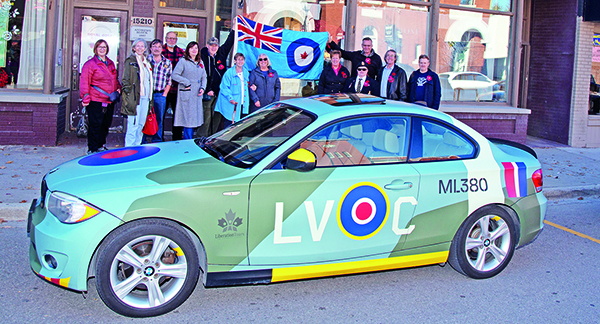General News » News
Aurora’s Angels project pays tribute to local airmen who paid ultimate sacrifice
November 14, 2024 · 0 Comments

Aurora’s Altar of Sacrifice has paid tribute to those who paid the ultimate sacrifice for King and Country during the Second World War – but as poignant as this tribute is, it doesn’t tell the full story of who these men were and where they served.
For the past 18 months, local historian Christopher Watts of the Aurora Heritage Authority, has been hard at work shedding a light on those who took to the air as part of his Aurora’s Angels project.
Over the last few weeks, you may have noticed striking banners along Yonge Street bearing the legend of Aurora’s Angels, each featuring the name and portrait of an airman, just in time to close out the Centennial year of the Royal Canadian Air Force.
“It’s a culmination of 18-months’ work connecting with Aurora’s past,” said Watts. “Aurora has already observed and had a proclamation for the Centennial of the RCAF back in April. It was important to do so because for a Town of its size, Aurora boasts proportionately a high number of its citizens enter the service for the RCAF.
“Some notable figures for this include former Prime Minister Lester B. Pearson, whose nickname Mike was given to him by his flying instructor back in 1917. Secondly, Dick Illingworth, former Mayor of Aurora who needs no introduction continued on after serving as a navigator in the Ferry Command in the RCAF in World War 2 to actually be an Auxiliary Officer with the rank of Wing Commander. These are two individuals who were lucky enough to come home, but not all were.”
The Aurora’s Angels project honours several homegrown RCAF members who were not so lucky.
“There is a saying you die twice – once when you stop breathing, the second when someone mentions your name for the last time,” said Watts, determined to keep these names on the lips of Aurorans evermore.
“To those who were close to them, they’re really known as friends, classmates, coworkers, brothers, fathers, sons and grandsons,” he said.
The name Aurora’s Angels was inspired by just one such individual – Lloyd Chadburn, a famed airman who was bestowed the “Angel” nickname.
“Chadburn was a student at Aurora Public School who made and flew model planes around Town before he was able to join up with the RCAF,” Watts explained. “It’s surprising Chadburn’s life hasn’t been made into a movie. [He] was the first Auroran to obtain the rank of Pilot Officer and proceed overseas in World War 2. He was the first graduate of the Commonwealth Air Training Plant to be given control of a squadron, the youngest Squadron Leader in the RCAF at 21, first to destroy an e-boat with cannon fire, the first RCAF officer to be decorated with the Distinguished Service order twice and one of only four in history, and the RCAF officer to receive the highest French honour, the Croix de Guerre.”
Each of the featured Aurora’s Angels have very different tales to tell, but all are united by their formative years in the community they called home, and some were even interconnected classmates.
Other honoured Angels include:
John Leslie Bradbury
John Harrison Cowieson
George Alvin Davis
Donald Banbury Douglas
Eric Walter Folliott
Burton Dix Howard
Harry Leslie Kay
William David King
Perry King
William Donald Pagan
Robert Mons Rumble
Jack Turp
Reginald Herbert Wade
Their legacy was celebrated at an art installation hosted at Aurora’s Royal Rose Gallery, curated by Watts, which culminated in a gathering on Saturday afternoon, which included a walking tour of the Yonge Street banners.
The project’s legacy will live on through a new partnership with the No Stone Left Alone initiative that helps engage Canadian students with wartime gravesites at home and abroad.
“We’re preparing kits to engage local schools for similar efforts here at home and in the years ahead,” said Watts, noting the work undertaken by Aurora’s Angels has led to author Rob Forbes rewriting his biography of Chadburn in the book, “Gone is the Angel.”
Efforts between Watts and Forbes are also afoot to nominate Chadburn for induction to Canada’s Aviation Hall of Fame.
By Brock Weir











